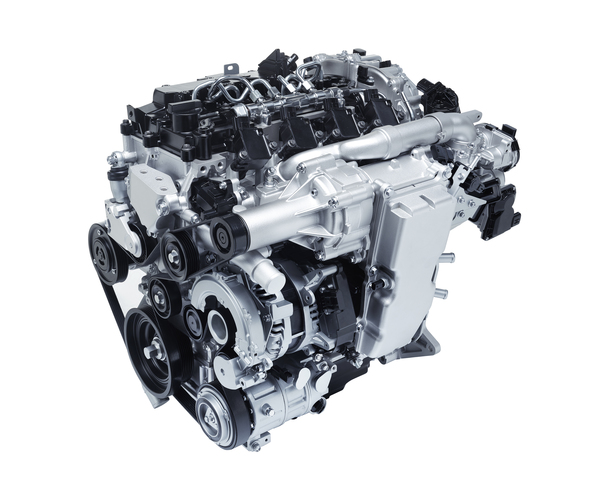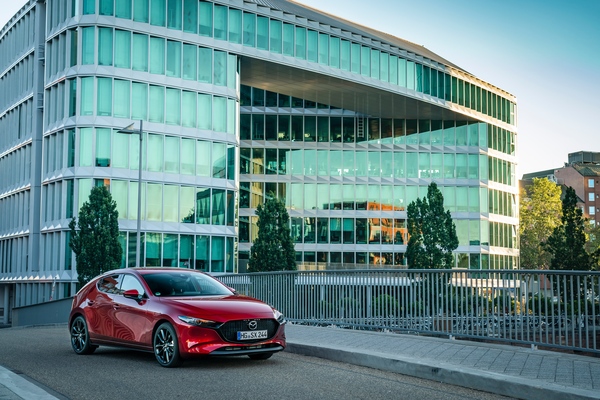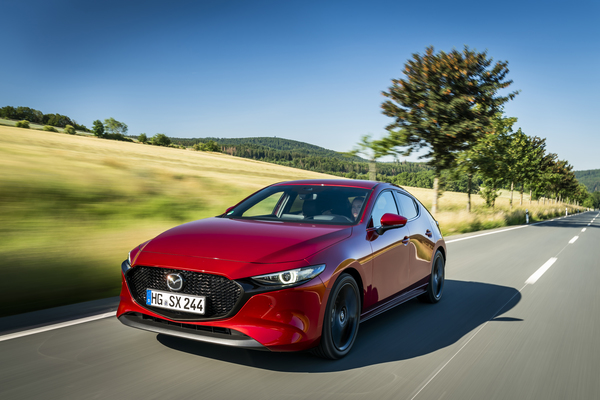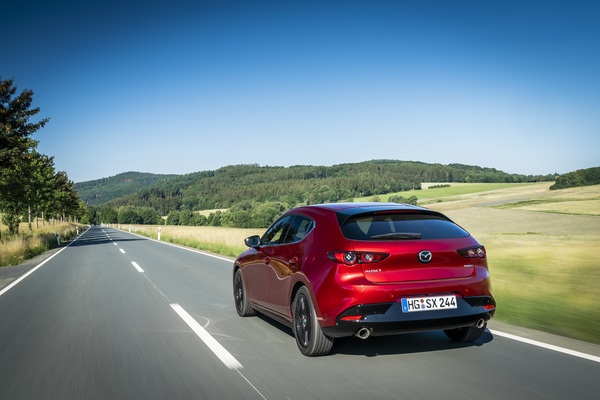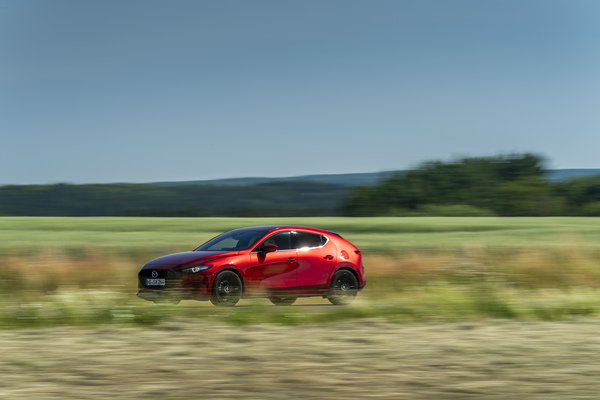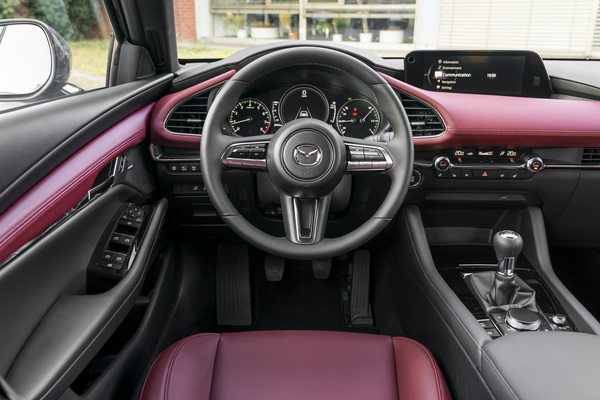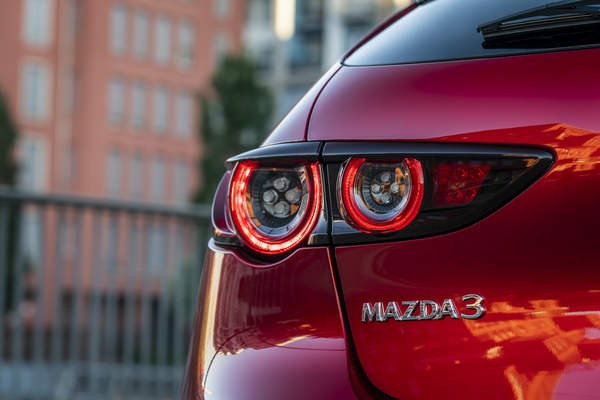
MAZDA e-SKYACTIV X
1 - AT A GLANCE
- An upgraded version of Mazda's unique e-Skyactiv X SPCCI (Spark Controlled Compression Ignition) petrol engine will be available in the latest, 2021 Mazda3 and CX-30 models.
- The performance of the upgraded e-Skyactiv X unite has been improved to generate an extra 6 PS of power and 16 Nm of torque. Torque and output have improved in almost all engine speed ranges, and torque most noticeably under acceleration from low revs. The Mazda3 and CX-30 e-Skyactiv X now delivers 186 PS (137 kW) at 6,000 rpm and maximum torque of 240 Nm at 4,000 rpm.
- Simultaneously, both fuel consumption and CO2 emissions have been lowered by 0.5 l/100 km and 10 g/km respectively. Euro 6d-compliant, the Mazda3 e-Skyactiv X now combines a WLTP measured combined fuel consumption of 6.5-5.0 l/100 km with CO2 emissions of 146-114 g/km. The Mazda CX-30 combines a WLTP measured combined fuel consumption of 6.6-5.7 l/100 km with CO2 emissions of 149-128 g/km.
- An outstanding engineering achievement, Mazda’s new 2.0 litre e-Skyactiv X engine is the world’s first production petrol unit to exploit the benefits of diesel-like compression ignition. Following the introduction of Skyactiv engine technologies in 2012, e-Skyactiv X represents Mazda's second step towards the development of the ideal internal combustion engine.
- e-Skyactiv X features Mazda's revolutionary Spark Controlled Compression Ignition (SPCCI). This radical new engineering concept allows the engine to switch seamlessly between conventional spark ignition and compression ignition combustion by using a spark to trigger both types of combustion in different ways.
- In SPCCI mode, a split injection process creates separate zones of fuel-air mixture inside the combustion chamber.
- First, a very lean fuel to air mixture is injected into the combustion chamber during the intake stroke, then a zone of atomised fuel is precisely injected directly around the spark plug during the compression stroke.
- The small injection of atomised fuel directly around the spark plug builds a richer core. When the spark fires, it ignites this core of fuel and air. This increases pressure in the combustion chamber to the point where the lean mixture rapidly combusts.
- Allowing the engine to run for a high percentage of time in a very efficient mode, SPCCI works in almost all ranges of engine operation except during cold starts, initial warm-up phases and at very high load. Under these circumstances, the engine seamlessly switches to normal operation, igniting a conventional stoichiometric air and fuel mixture of 14.7:1.
- Improvements in both power and efficiency have been achieved through adjusting e-Skyactiv X’s compression ratio from 16.3:1 to 15.0:1. Modifications include the optimisation of combustion control, modified pistons, and the updating of the Mazda M Hybrid system software. Fitted as standard, the e-Skyactiv X's Mazda M Hybrid system further enhances both efficiency and driving comfort.
- This not only results in a broader operating band of combustion efficiency, but also effects even higher ignition stability – further minimising the already very low risk of unexpected self-ignition or pre-ignition due to the variability of fuel quality in different markets.
- Conversely, with improvements being especially great in the light engine load range, it improves fuel economy, and reduces CO2 and NOX emissions, challenging the commonly-held belief that a large engine displacement means poor fuel economy.
- e-Skyactiv Xe-Skyactiv Xe-Skyactiv X is on the Mazda3 and the CX-30 available with either Skyactiv-MT 6-speed manual transmission (6MT) or Skyactiv-Drive 6-speed automatic transmission (6AT). The powertrain line-up features front-wheel-drive (FWD) as standard, with Mazda’s unique i-Activ all-wheel-drive (AWD) optionally available for Mazda3 hatchback variants and the CX-30.
- e-Skyactiv X versions accounted for more than 40% of Mazda3 and CX-30 European sales in 2020.
Mazda e-Skyactiv X – Engine Details*
Powertrain FWD / i-Activ AWD**
Transmission 6MT / 6AT
Displacement 1,998
Compression ratio 15.0:1
Mazda M Hybrid Standard
i-Stop Standard
Max. power 137 (186) / 6,000
Max. torque 240 / 4,000
Recommended fuel type 95 RON
Exhaust gas cleaning system Three-way-catalyst, Gasoline Particulate Filtre (GPF)
Emission rating Euro 6d
* Valid for Mazda3 and CX-30 e-Skyactiv X 2.0. Mazda3 e-Skyactiv X 2.0: WLTP fuel consumption: 6.5-5.0 l/100 km; CO2 emissions: 146-114 g/km. NEDC fuel consumption: 5.5-4.5 l/100 km; CO2 emissions: 124-101 g/km. Mazda CX-30 e-Skyactiv X 2.0: WLTP fuel consumption: 6.6-5.7 l/100 km; CO2 emissions: 149-128 g/km. NEDC fuel consumption: 5.6-4.9 l/100 km; CO2 emissions: 127-111 g/km. Vehicles are homologated in accordance with the type approval procedure WLTP (Regulation (EU) 1151 / 2017; Regulation (EU) 2007/715). To provide comparability the referred values are NEDC – values determined in line with Implementation Regulation (EU) 1153 / 2017.
** Optional on Mazda3 Hatchback and CX-30.
2 - CONCEPT AND AIMS OF SPCCI TECHNOLOGY
Featuring Spark Controlled Compression Ignition (SPCCI), a Mazda unique combustion method, the e-Skyactiv X engine represents the second step in Mazda’s quest to develop a petrol engine with the ideal internal combustion mechanism.
Developing compression ignition for petrol engines has long been a goal of engineers. e-Skyactiv X is a ground-breaking new engine, exclusive to Mazda, in which spark plug ignition is used to control compression ignition, resulting in dramatic improvements across a range of important performance areas.
The benefits of a spark-ignition petrol engine – expansiveness at high rpm and cleaner exhaust emissions – have been combined with those of a compression-ignition diesel engine – superior initial response and fuel economy – to produce a crossover engine that delivers the best of both worlds.
Mazda believes that there is still ample room for further evolution of the internal combustion engine and that this technology has the potential to contribute in a major way to the conservation of our global environment.
Based on Mazda’s corporate vision of protecting our beautiful planet while enriching people’s lives through the 'joy of driving', we plan to continue on our ceaseless quest to develop the ideal combustion engine.
Advantages of lean burn, and associated issues
Mazda has undertaken a fundamental re-examination of the nature of combustion, with the aim of making some major improvements in the efficiency of the internal combustion process.
Mazda’s Skyactiv-G petrol engine boosts combustion efficiency by raising the compression ratio, while cooling losses from the zone of the heat transfer to the chamber wall are reduced through control of cooling water temperatures. Pumping losses and mechanical resistance are reduced through use of the Miller cycle.
In the e-Skyactiv X, the latest Skyactiv engine, we have worked to boost the air-fuel ratio. In order to do this, we had to enable lean burn, in which larger quantities of air are combusted.
The ideal (stoichiometric) air-fuel ratio is 14.7:1. Creating a higher air-to-fuel ratio by more than doubling the amount of air raises the specific heat ratio and lowers the combustion gas temperature. This, in turn, reduces cooling losses. Meanwhile, a design that introduces larger amounts of air reduces the losses from throttle closure, resulting in improved fuel economy.
However, if this kind of lean mixture of air and petrol is burned using the flame propagation-based combustion which occurs when a spark plug is used, combustion tends to become unstable.
To overcome this problem, compression combustion in high-temperature, high-pressure conditions must be employed. This means that such an engine will need to adopt the compression ignition used by diesel engines.
In developing the e-Skyactiv X, Mazda has improved the seven control factors which have a main influence to the effiency of an internal combustion engine.
These include the compression ratio (which needs to be raised in order to realize the required high-temperature, high-pressure conditions), combustion timing near top dead centre (which is found in compression ignition), and a combustion period in which all the fuel burns simultaneously.
Issues associated with homogenous charge compression ignition (HCCI)
One concept underpinning compression ignition in petrol engines is Homogenous Charge Compression Ignition (HCCI).
Conventional gasoline engines use a spark plug for the ignition. The combustion has to spread out from the initial spark, which results in a slow combustion speed. If, in addition to this, a leaner air-fuel mixture with more air is used, the flames created by the spark plug will fail to spread throughout the combustion chamber.
With compression ignition, however, all fuel in the combustion chamber combusts simultaneously, resulting in a far higher combustion speed which, in turn, means that a leaner air-fuel mixture can be burned.
However, HCCI has not yet reached the point where it can be used in commercial applications because it is only used at low rpm and engine load ranges, and even these ranges are apt to change depending on driving conditions.
Furthermore, the very limited range across which HCCI can take place makes it difficult to achieve frequent, stable and seamless switching between spark ignition - required for higher rpm and engine loads - and compression ignition.
Until now, overcoming these issues had required a major increase in the compression ratio, a more complex structure and the addition of high-precision controls.
3 - SPARK CONTROLLED COMPRESSION IGNITION: THE BREAKTHROUGH THAT HAS MADE SKYACTIV-X POSSIBLE
Mazda’s breakthrough has been achieved by questioning the conventional idea that no spark plug is needed for compression ignition and suggesting a different approach instead, in which the spark plug plays a role in both combustion methods. This concept is the basis of Spark Controlled Compression Ignition (SPCCI), Mazda’s unique combustion method.
Using SPCCI means that the engine load and rpm range wherein compression ignition can take place has now dramatically expanded, allowing this technology to be used in almost all driving conditions.
Moreover, because a spark plug is now being used at all times, the engine can switch seamlessly between combustion using compression ignition and combustion using spark ignition.
Key Technological Features of SPCCI
Although SPCCI is an entirely new combustion method, it is based on two existing functions - ignition and injection - which Mazda has further refined and meticulously recombined.
To do this, Mazda has further developed several elementary technologies – a new piston head design, a super-high-pressure fuel injection system to support compression ignition, and a high-response air supply unit which can deliver larger amounts of air – and combined these with an in-cylinder pressure sensor which serves to control the entire combustion process.
Compared with the complicated structures that were previously required in order to utilise the HCCI concept, the hardware for SPCCI is simple and lean, with no unnecessary complexity.
Using Compression Effects Created by A Spark
The SPCCI mechanism can be summarised as a system in which the compression effect of spark-ignited localised combustion is used to achieve the required pressure and temperature to bring about compression ignition.
In other words, the geometric compression ratio is raised to the point where the air-fuel mixture is on the verge of igniting (due to compression) at top dead centre. At this point, an expanding fireball created by spark ignition provides the final push that causes the whole mixture to combust via compression ignition.
The timing and amount of pressure required are in a continual state of flux depending on constantly changing driving conditions. But the SPCCI system is able to control the spark plug ignition timing, meaning that pressure and temperature within the combustion chamber can be optimised at all times.
Because a spark plug is used all the time, the system is able to switch seamlessly to spark ignition combustion in rpm or load ranges where compression ignition would be difficult. In this way, the system ensures that the compression ratio is never raised too high, while enabling a simple design which does not require complicated features such as a geometrical variable compression ratio.
Fuel Density Distribution within the Air-Fuel Mixture
The e-Skyactiv X unit controls the distribution of the air-fuel mixture in order to enable lean burn using the SPCCI mechanism. First, a lean air-fuel mixture for compression ignition is distributed throughout the combustion chamber. Next, precision fuel injection and swirl is used to create a zone of richer air-fuel mixture - rich enough to be ignited with a spark and to minimize nitrous oxide production-around the spark plug. Using these techniques, SPCCI ensures stable combustion.
Controlling the air-fuel mixture to prevent abnormal combustion
Split fuel injection
In order to prevent the abnormal combustion which can occur when rich air-fuel mixtures are compressed for long periods of time (a longstanding issue for HCCI), SPCCI adopts a split fuel injection system, in which part of the fuel is injected during the air intake process and part is injected during the compression process.
First, the low-density lean mixture for the lean burn is injected during the air intake process. Then, during the compression stroke, a separate injection creates the richer air-fuel mixture that is ignited around the spark plug.
This not only distributes the density of the air-fuel mixture so as to allow SPCCI to take place, but also minimises the time lag until the air-fuel mixture ignites under compression, effectively controlling abnormal combustion.
Super-high-pressure fuel injection system
To minimize compression time and make compression ignition as efficient as possible, the fuel must be vaporized and atomized very quickly, and then immediately dispersed around the whole of the cylinder.
e-Skyactiv X therefore features a system capable of injecting fuel at super-high pressure from a multi-hole fuel injector positioned in the centre of the combustion chamber. This causes the fuel to be vaporized and atomized instantly, while powerful turbulence is simultaneously created, greatly improving ignition stability and combustion speed.
Super-high-pressure fuel injection enables SPCCI, which suppresses abnormal combustion even at full throttle/low rpm where traditional petrol engines have to retard ignition and thus sacrifice efficiency and power.
Adoption of the in-cylinder pressure sensor
In addition to these technologies for preventing abnormal combustion, an in-cylinder pressure sensor has also been introduced as a monitoring control. By continually observing whether the above controls are bringing about proper combustion and compensating in real time for any deviations from intended norms, it ensures continuously optimised combustion.
Based on the techniques set out above, SPCCI has expanded the zone of compression ignition right into the full throttle range, and enables smooth switching between SPCCI combustion and spark ignition combustion.
This new combustion method does not merely use spark ignition to assist compression ignition, but delivers an all-encompassing combustion control system which includes control of in-cylinder temperature and pressure, and control of the fuel injection’s air-fuel mixture distribution density and exhaust gas recirculation (EGR).
4 - BENEFITS PROVIDED BY e-SKYACTIV X
e-Skyactiv Xe-Skyactiv X's revolutionary SPCCI technology represents the start of an exciting new stage in our quest to develop the ideal internal combustion engine, fully supporting the Jinba Ittai driving experience Mazda aims to provide.
The main development goal of e-Skyactiv X was to provide a highly efficient petrol engine that supports everyday driving with a combination of excellent response, engaging, free-revving performance, smoothness and superior real world fuel and emissions efficiency.
Excellent response
Like that of a diesel engine, the throttle valve of e-Skyactiv X is almost always open. In other words, there is lots of air in the cylinders. As a result, the engine generates torque instantly in response to the drivers demand.
The e-Skyactiv X features a highly rigid drivetrain which transfers the driving force smoothly and promptly. By using a high rigid drivetrain, longitudinal vibrations can be avoided.
When pressing on the accelerator, drivers anticipate the car’s response and unconsciously try to balance themselves. e-Skyactiv X provides such an immediate response to the throttle that the driver's balance is stable and controlling the car feels natural and effortless.
Free-revving feel
e-Skyactiv X is designed to deliver a free-revving feel, inspired by the iconic Mazda MX-5. To achieve this, e-Skyactiv X will spin up into higher rpm ranges as smoothly and easily as a typical petrol engine. It delivers a very consistent and linear power output, peaking at 186 PS at 6,000 rpm.
e-Skyactiv Xe-Skyactiv Xe-Skyactiv XThe free-revving feel e-Skyactiv X achieves is based on the sensation of acceleration and a good quality engine sound which matches the acceleration rate. A capsule structure has been adopted for the engine bay, which enhances the sound and matches it to the acceleration rate of the car.
The capsule structure traps also heat and keeps the engine warm which benefits real world fuel economy.
Smoothness
On engine re-start, the Mazda M Hybrid system's belt driven integrated starter generator (ISG) raises the rpm more than a conventional starter would, promptly re-starting the engine and allowing a quiet and responsive re-launch and acceleration.
When engine resistance is small and the rpm do not drop well during manual transmission upshift operations, shift shocks can easily occure. To counter this, the regenerative ISG intervenes to rapidly drop and adjust the engine rpm to match the next gear ratio, giving a shock -free gearshift. Skyactiv-MT 6-speed manual transmission also has close ratios to facilitate a nimble and smooth gear change.
The time taken by the Skyactiv-Drive 6-speed automatic transmission to complete downshifts has been reduced in order to smooth out the gear changes. The rate of acceleration before and after gear changes has also been realigned to match, further smoothing out automatic shifting.
Real world fuel consumption
e-Skyactiv X is able to deliver excellent fuel economy over a broad operating range, despite its 2.0 litre displacement. The engine delivers notably low fuel consumption in a wide variety of driving scenarios, including both urban and long-distance motorway driving.
By using a lean air/fuel mixture in conjunction with SPCCI, excellent fuel efficiency is expanded over a wide range of engine loads and rpm. The e-Skyactiv X 2.0 litre engine also produces very low levels of CO2 and NOX emissions. For exhaust gas treatment, e-Skyactiv X adopts both a three-way-catalyst and a Gasoline Particulate Filter (GPF), cleaning exhaust air for the air supply unit that provides enough air to create a lean combustion at high engine revs.
The Mazda3 and CX-30 e-Skyactiv X meet the Euro 6d emissions rating. The Mazda3 returns WLTP measured combined fuel consumption of 6.5-5.0 l/100 km and generates WLTP CO2 emissions of 146-114 g/km. The CX-30 achieves WLTP measured combined fuel consumption of 6.6-5.7 l/100 km and WLTP CO2 emissions of 149-128 g/km.
5 - ELECTRIFICATION FOR BETTER FUEL ECONOMY: MAZDA M HYBRID
All Skyactiv petrol engines powering the Mazda3 and Mazda CX-30 are equipped, as standard, with the company's new Mazda M Hybrid system.
Compact and efficient, the mild hybrid system features a belt-driven integrated starter generator (ISG) and a 24V lithium-ion battery. It supports greater gains in fuel economy by recycling energy recovered during deceleration and powering the ISG, functioning as an electric motor, to assist the engine.
The ISG converts the recovered kinetic energy into electric power and stores it in the lithium-ion battery. The system then uses a DC-DC converter to transform that voltage to the appropriate level, and supplies it to the car’s electrical equipment.
Adopting the belt-driven ISG also delivers a refined drive feel by enabling the system to provide drive assist and helping the engine restart more quickly and quietly after shutting down for idling stop. The lithium-ion battery is mounted between the wheels, minimising its impact on interior space, while helping to optimise weight distribution and contributing to collision safety.
The Mazda M Hybrid system not only enhances the vehicle's environmental performance, but also ensures better drivability. When the car is starting accelerating or coming to a stop, transitions feel smooth and natural. By substituting engine torque for motor torque, the hybrid system can achieve the same acceleration as a petrol engine alone, while using less fuel. The driver enjoys all the benefits of mild hybrid technology without any sacrifice in driving pleasure.
6 - MAZDA 2021 e-SKYACTIV X UPDATES
e-Skyactiv X's SPCCI (Spark Controlled Compression Ignition) technology makes it the world's first commercial petrol unit to combine the spark ignition of a petrol engine with the compression ignition of a diesel, maximising the benefits of both fuel types and ignition systems. This important technological milestone having made its first appearance in the 2019 Mazda3, the Japanese carmaker believes there is significant scope for its ongoing evolution, and aims to reveal the full potential enabled by this technology. Accordingly, Mazda has further developed its unique e-Skyactiv-X SPCCI petrol engine, an upgraded, 2021 version of which - combining higher performance with greater efficiency - is now available in the latest, 2021 Mazda3 and CX-30 models.
e-Skyactiv X is designed to deliver exciting, free-revving performance and a smooth, precise engine response, offering drivers a uniquely intuitive and engaging driving experience which exemplifies the company’s Jinba Ittai – driver and car as one – engineering ethos. This is combined with superior real-world fuel and emissions efficiency - the engine producing lower CO2 levels than comparable petrol engines with the same 2.0 litre displacement.
IMPROVEMENTS PROVIDED BY 2021 e-SKYACTIV X
The updated, 2021 e-Skyactiv-X engine realises improvements to its excellent response and effortless control, as well as its exhilarating free-revving feel, precision and smoothness. This has been achieved through an evolution of the SPCCI technology, which now offers greater precision of combustion control, an adjusted, optimised compression ratio and intake valve timing adaptations. Updates to the e-Skyactiv X's Mazda M Hybrid system's software have further enhanced precision and smoothness, with the system’s belt-driven integrated starter generator (ISG) now reacting even more quickly to provide torque on demand.
2021 e-Skyactiv X Mazda3 and CX-30 models benefit from improved performance, with an extra 16 Nm of torque and 6 PS of power. As a result maximum torque rises to 240 Nm at 4,000 rpm, and maximum power output rises to 186 PS (137 kW) at 6,000 rpm. Torque output has improved in almost all engine speed ranges, and a more expansive revving feel and improved acceleration performance are delivered under full engine load above 2000 rpm.
Most significantly, 2021 e-Skyactiv X models benefit from an increased driving force and responsiveness in gears one to five under acceleration from low revs in partial-load driving situations commonly found during daily driving - such as accelerating from 30-80 in 3rd gear to overtake, or accelerating when merging with traffic or leaving a roundabout.
The further evolved SPCCI technology also expands the range of driving scenarios within which the engine is able to deliver lower fuel consumption than ever before, particularly in engine load situations found when accelerating, without compromising the delivery of power or acceleration. Hence the updated e-Skyactiv X engine maintains the areas of already very good fuel consumption of the previous generation engine, whilst adding further areas of good and very good fuel consumption, particularly when driving under medium and higher engine loads.
As a result, fuel economy has been improved throughout almost all driving scenarios - in cities, sub-urban situations and on the highway. WLTP fuel consumption has been further lowered by up to 0.5 l/100 km, and CO2 emissions by up to 10 g/km compared to the previous version of the engine. A 2021 Mazda3 hatchback equipped with Skyactiv-MT 6-speed manual transmission, FWD and 18-inch wheels now achieves WLTP measured combined fuel consumption of 5.3 l/100km and combined CO2 emissions of 121 g/km.
MEASURES TAKEN TO FURTHER EVOLVE e-SKYACTIV X
In facilitating these improvements in both performance and fuel economy, the engine’s unique SPCCI technology has not changed, but further evolved. Rather, the updates of the 2021 e-Skyactiv X engine have been achieved through technical and software updates. These include an adjusted compression ratio through modified pistons with a new piston head shape, intake valve timing adaptation, optimised Mazda M Hybrid system ISG control and, an engine re-calibration.
The e-Skyactiv X engine's compression ratio has been adjusted from 16.3:1 to 15.0:1 by using modified pistons with a new piston head shape. In conjunction with engine re-calibration, this leads to greater combustion control within the SPCCI. This not only results in a broader operating band of combustion efficiency - particularly under higher engine loads, but also effects even greater ignition stability, further minimising the already very low risk of unexpected self-ignition or pre-ignition due to the variability of fuel quality in different markets. As a result, e-Skyactiv X not only delivers higher maximum engine torque, but also improved real-world fuel economy.
The intake valve timing has been adapted through modifying the intake camshaft. This further increases the engine’s specific heat ratio and leads to a reduction in pumping losses (larger valve overlaps reducing gas exchange losses), resulting in improvements to the e-Skyactiv X's real-world fuel consumption.
Fitted as standard, the Skyactiv-X's 24 Volt Mazda M Hybrid system further enhances both efficiency and driving comfort, improving drivability and controllability whilst simultaneously recuperating energy. It helps improve fuel economy by re-using energy regenerated during deceleration and braking, and via an electric motor that provides permanent assistance to the engine. By substituting engine torque for motor torque, the hybrid system can achieve the same acceleration as a combustion-engine alone, while using less fuel. Updating the Mazda M Hybrid software enables faster reactions of the system’s belt-driven ISG's torque control. This improvement in control smoothes vehicle drivability further by increasing or reducing torque when needed, for example when e-Skyactiv X’s air supply unit turns on – specifically to provide sufficient air for the lean combustion fuel-air mixture – or off again, creating torque fluctuations. The Mazda M Hybrid software now instigates torque reactions - generated through the belt-driven ISG - that are quick enough to flatten the torque curve. As a result, the engine feels even smoother during linear acceleration.
The updates made to the engine, and the evolved combustion improvements in particular, lead to an increase in driving force in gears one to five. This leads to better acceleration in these gears - particularly noticeable in real world driving situations when starting in gear one and above 3000rpm in gears two, three and four – and an improved acceleration feeling after downshifts, especially when shifting down from sixth to fifth at higher driving speeds.
2021 e-SKYACTIV X IN SUMMARY
The updated 2021 e-Skyactiv X benefits from higher SPCCI combustion efficiency and further delivers improved fuel economy, mostly gained in mid- and higher-load acceleration driving situations. Increased torque in partial engine-load situations offer drivers a better performance feel, particularly in low- and mid-engine load situations often found in daily traffic driving.
Improved compression efficiency not only leads to better torque output and greater fuel and emission efficiency, but also noticeably improved driving force in gears one to five. In terms of performance and efficiency, the updates are therefore particularly noticeable in real world driving situations. Following perceptible updates in engine torque whilst driving, maximum torque has increased to 240 Nm at 4,000 rpm and power output to 186 PS (137 kW at 6,000 rpm). WLTP fuel consumption been further lowered by up to 0.5 l/100 km, and CO2 emissions by up to 10 g/km compared to the previous version of the engine. Enhancements to e-Skyactiv X’s responsiveness and smoothness lead to even greater Jinba Ittai driving pleasure.
e-Skyactiv X versions accounted for more than 40% of Mazda3 and CX-30 European sales in 2020. For 2021, the 2.0 litre e-Skyactiv X petrol engine is available with a choice of six-speed Skyactiv-MT manual or six-speed Skyactiv-Drive automatic transmissions. Mazda3 hatchback and Mazda CX-30 e-Skyactiv X may be fitted with the optional i-Activ all-wheel drive (AWD) powertrains.
7 - ENGINE SPECIFICATIONS
MAZDA3 e-SKYACTIV X PERFORMANCE - HATCHBACK AND SEDAN
| HATCHBACK | SEDAN | |||||||
|---|---|---|---|---|---|---|---|---|
| Transmission | 6MT | 6AT | 6MT | 6AT | 6MT | 6AT | ||
| Powertrain | FWD | FWD | AWD | AWD | FWD | FWD | ||
| Performance | ||||||||
| Top speed (w. limiter) | km/h | 216 | 216 | 210 | 210 | 216 | 216 | |
| Acceleration (0-100km/h)* | secs. | 8.1 | 8.5 | 8.3 | 8.8 | 8.1 | 8.4 | |
| WLTP Fuel consumption** | ||||||||
| Combined | l/100 km | 16 inch | 5.2 | 5.8 | - | - | 5 | 5.7 |
| 18 inch | 5.3 | 6 | 6 | 6.5 | 5.1 | 5.9 | ||
| Extra-High | l/100 km | 16 inch | 5.4 | 6.3 | - | - | 5.2 | 6.1 |
| 18 inch | 5.6 | 6.5 | 6.5 | 6.8 | 5.3 | 6.4 | ||
| High | l/100 km | 16 inch | 4.6 | 5.1 | - | - | 4.5 | 5 |
| 18 inch | 4.7 | 5.2 | 5 | 5.7 | 4.6 | 5.2 | ||
| Medium | l/100 km | 16 inch | 4.9 | 5.4 | - | - | 4.8 | 5.4 |
| 18 inch | 5 | 5.5 | 5.8 | 6.3 | 4.9 | 5.5 | ||
| Low | l/100 km | 16 inch | 6.5 | 7.2 | - | - | 6.4 | 7.1 |
| 18 inch | 6.5 | 7.3 | 7.5 | 7.9 | 6.4 | 7.3 | ||
| CO2 emissions (combined) | g/km | 16 inch | 118 | 133 | - | - | 114 | 130 |
| 18 inch | 121 | 137 | 135 | 146 | 117 | 135 | ||
| NEDC Fuel consumption*** | ||||||||
| Combined | l/100 km | 16 inch | 4.7 | 5.2 | - | - | 4.5 | 5.1 |
| 18 inch | 4.7 | 5.3 | 5.1 | 5.5 | 4.6 | 5.4 | ||
| Extra urban | l/100 km | 16 inch | 4.2 | 4.7 | - | - | 4 | 4.6 |
| 18 inch | 4.2 | 4.8 | 4.6 | 5.1 | 4.1 | 4.9 | ||
| Urban | l/100 km | 16 inch | 5.6 | 6.3 | - | - | 5.5 | 6.2 |
| 18 inch | 5.6 | 6.3 | 6 | 6.3 | 5.6 | 6.4 | ||
| CO2 emissions (combined) | l/100 km | 16 inch | 105 | 119 | - | - | 101 | 117 |
| 18 inch | 106 | 120 | 116 | 124 | 104 | 121 | ||
| Emissions rating | Euro 6d | |||||||
MAZDA3 e-SKYACTIV X PERFORMANCE - SUV
| SUV | ||||||
|---|---|---|---|---|---|---|
| Transmission | 6MT | 6AT | ||||
| Powertrain | FWD | AWD | FWD | AWD | ||
| Performance | ||||||
| Top speed (w. limiter) | km/h | 204 | 204 | 204 | 204 | |
| Acceleration (0-100km/h)* | secs. | 8.3 | 8.7 | 8.6 | 9 | |
| WLTP Fuel consumption** | ||||||
| Combined | l/100 km | 16 inch | 5.7 | 6.1 | 6.1 | 6.6 |
| 18 inch | ||||||
| Extra-High | l/100 km | 16 inch | 6.1 | 6.4 | 6.5 | 7.2 |
| 18 inch | ||||||
| High | l/100 km | 16 inch | 5.0 | 5.4 | 5.3 | 5.7 |
| 18 inch | ||||||
| Medium | l/100 km | 16 inch | 5.4 | 5.9 | 5.8 | 6.1 |
| 18 inch | ||||||
| Low | l/100 km | 16 inch | 6.6 | 7.3 | 7.5 | 7.9 |
| 18 inch | ||||||
| CO2 emissions (combined) | g/km | 16 inch | 128 | 137 | 138 | 149 |
| 18 inch | ||||||
| NEDC Fuel consumption*** | ||||||
| Combined | l/100 km | 16 inch | 4.9 | 5.1 | 5.5 | 5.6 |
| 18 inch | ||||||
| Extra urban | l/100 km | 16 inch | 4.5 | 4.6 | 4.9 | 5.1 |
| 18 inch | ||||||
| Urban | l/100 km | 16 inch | 5.8 | 6.0 | 6.7 | 6.5 |
| 18 inch | ||||||
| CO2 emissions (combined) | l/100 km | 16 inch | 111 | 116 | 124 | 127 |
| 18 inch | ||||||
| Emissions rating | Euro 6d | |||||
* To provide comparability the referred values are NEDC – values determined in line with Implementation Regulation (EU) 1153 / 2017.
** Under Mazda test conditions without sun roof.
*** Vehicles are homologated in accordance with the type approval procedure WLTP (Regulation (EU) 1151 / 2017; Regulation (EU) 2007/715).












